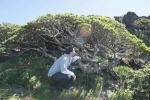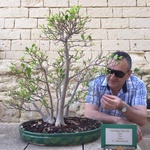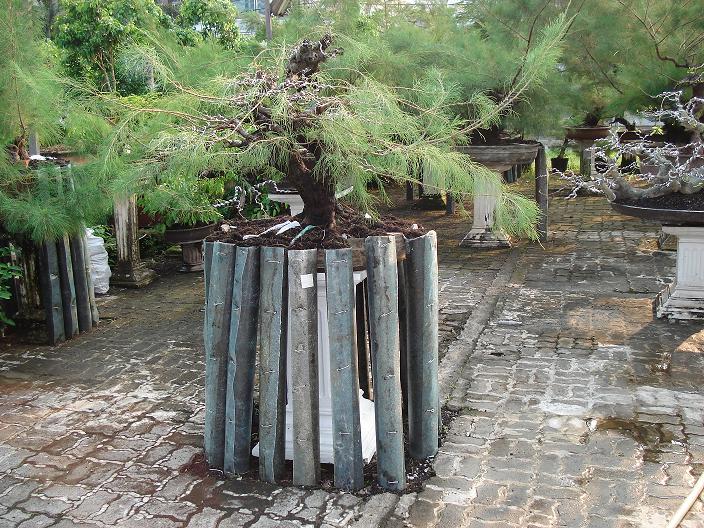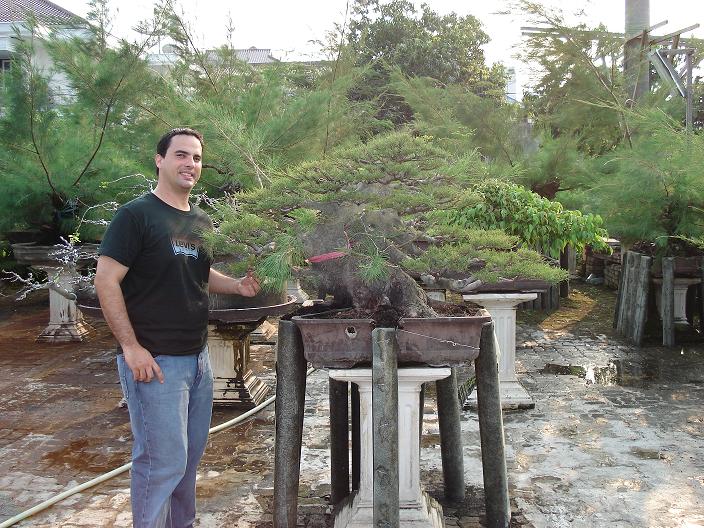Casuarina Equisetifolia (Cemara Udang or Mu Ma Huang)
+26
Khaimraj Seepersad
my nellie
ponsmaldo
Robert Steven
ogi uyehara
jonathan e
siriwatn
kcpoole
Peter Woosley
craigw
BonsaiAndino
allan
leonardo
Ka Pabling
gm.it.seacom
Ed Trout
Chris Cochrane
Rob Kempinski
ArtAtkinson
cosmos
priya uthama
hiram
Billy M. Rhodes
sentot
Garykk
jrodriguez
30 posters
Page 2 of 5
Page 2 of 5 •  1, 2, 3, 4, 5
1, 2, 3, 4, 5 
 Re: Casuarina Equisetifolia (Cemara Udang or Mu Ma Huang)
Re: Casuarina Equisetifolia (Cemara Udang or Mu Ma Huang)
Cosmos,
I tend to style all my trees by combining the Grow and Cut method and the wiring techniques. I just let the branches grow out. When they reach the desired thickness, i cut and waut for a new shoot to grow. Once the new one grows, i wire into the desired position and begin the whole process again. This is an excellent way to create tapering branches and trunks. Also, it is a very effectuve method of not having a single scar on the bonsai, thus increasing its value.
Rob,
I remember this casuarina from the old forum. It has developed quite nicely. See you next week!!
Kind regards,
Jose
I tend to style all my trees by combining the Grow and Cut method and the wiring techniques. I just let the branches grow out. When they reach the desired thickness, i cut and waut for a new shoot to grow. Once the new one grows, i wire into the desired position and begin the whole process again. This is an excellent way to create tapering branches and trunks. Also, it is a very effectuve method of not having a single scar on the bonsai, thus increasing its value.
Rob,
I remember this casuarina from the old forum. It has developed quite nicely. See you next week!!
Kind regards,
Jose

jrodriguez- Member
 Re: Casuarina Equisetifolia (Cemara Udang or Mu Ma Huang)
Re: Casuarina Equisetifolia (Cemara Udang or Mu Ma Huang)
Jose notes:
Well, not exactly... Lu jun ("robin's egg"/mottled blue) glaze was first created in the Qing dynasty (Yongzheng period 1723-35), I believe, & perfected in the Qianlong period (1736-1795). It might have been born of trying to recreate mottled glazes from Ming dynasty Jingdezhen kilns, but robin's egg blue glaze was not a Ming dynasty product.Lujin glaze dates back to the Ming dynasty.

Chris Cochrane- Member
 Re: Casuarina Equisetifolia (Cemara Udang or Mu Ma Huang)
Re: Casuarina Equisetifolia (Cemara Udang or Mu Ma Huang)
Chris,
You are right. I got them mixed up. Thanks for the clarification.
Kind regards,
Jose Luis
You are right. I got them mixed up. Thanks for the clarification.
Kind regards,
Jose Luis

jrodriguez- Member
 Casuarina equisetifolia grafting
Casuarina equisetifolia grafting
Hi, can the casuarina be grafted? If so, what type of grafting can be done? Thanks.
Cosmos
Cosmos

cosmos- Member
 Re: Casuarina Equisetifolia (Cemara Udang or Mu Ma Huang)
Re: Casuarina Equisetifolia (Cemara Udang or Mu Ma Huang)
Cosmos,
Yes, Casuarina can be grafted and they take very well. Approach grafts are best, but you can also make bud grafts with a high success rate.
Kind regards,
Jose Luis
Yes, Casuarina can be grafted and they take very well. Approach grafts are best, but you can also make bud grafts with a high success rate.
Kind regards,
Jose Luis

jrodriguez- Member
 Re: Casuarina Equisetifolia (Cemara Udang or Mu Ma Huang)
Re: Casuarina Equisetifolia (Cemara Udang or Mu Ma Huang)
Jose Luis and Rob
Thank you for your response. I have tried to layer Casuarina but was only successful with one that was already in a pot. The ones in the wild failed. Either wrong time of year or lack of care.
When I have attempted to collect trees I have put them in protected areas but have not yet tried the 'bag for humidity' idea yet. Will try that in the future.
They seem to be good subjects once they get established, but are difficult to collect if the trunk is over 2 cms wide. I've even lost one in a transplant. As I said before I have 4 growing and they seem to respond well to pruning. As a matter of fact they are quite commonly grown as pruned hedges here in Barbados, which is usually a good indicator of good bonsai material.
Just a comment in passing: I know that this is a whole other subject but the mature bonsai trees I see on the net bear no resemblance to large trees in nature except those severely windswept and no one seems to style their bonsai that way - except maybe me. But I suppose you could say the same for pines.
Art
Thank you for your response. I have tried to layer Casuarina but was only successful with one that was already in a pot. The ones in the wild failed. Either wrong time of year or lack of care.
When I have attempted to collect trees I have put them in protected areas but have not yet tried the 'bag for humidity' idea yet. Will try that in the future.
They seem to be good subjects once they get established, but are difficult to collect if the trunk is over 2 cms wide. I've even lost one in a transplant. As I said before I have 4 growing and they seem to respond well to pruning. As a matter of fact they are quite commonly grown as pruned hedges here in Barbados, which is usually a good indicator of good bonsai material.
Just a comment in passing: I know that this is a whole other subject but the mature bonsai trees I see on the net bear no resemblance to large trees in nature except those severely windswept and no one seems to style their bonsai that way - except maybe me. But I suppose you could say the same for pines.
Art
ArtAtkinson- Member
 Re: Casuarina Equisetifolia (Cemara Udang or Mu Ma Huang)
Re: Casuarina Equisetifolia (Cemara Udang or Mu Ma Huang)
Last edited by Ed Trout on Fri Jul 03, 2009 9:13 pm; edited 1 time in total
Ed Trout- Member
 Re: Casuarina Equisetifolia (Cemara Udang or Mu Ma Huang)
Re: Casuarina Equisetifolia (Cemara Udang or Mu Ma Huang)
Art,
Do try the plastic bag method to establish your trees. I believe it will serve you right.
Like you said, Casuarina bonsai is trained in a different way to the style and nature of their ecological conditions. I believe it is due to the fact that people in the tropics have a need to quench their thirst for conifer bonsai.
Taking your comments into consideration, i do have other material that can be trained into windswept and multiple trunk style, both forms quite common in natural casuarina. MY demo tree in the Bali ASPAC is a true winswept tree. When it is fully mature, i'll post some pictures.
Kind regards,
Jose Luis
Do try the plastic bag method to establish your trees. I believe it will serve you right.
Like you said, Casuarina bonsai is trained in a different way to the style and nature of their ecological conditions. I believe it is due to the fact that people in the tropics have a need to quench their thirst for conifer bonsai.
Taking your comments into consideration, i do have other material that can be trained into windswept and multiple trunk style, both forms quite common in natural casuarina. MY demo tree in the Bali ASPAC is a true winswept tree. When it is fully mature, i'll post some pictures.
Kind regards,
Jose Luis

jrodriguez- Member
 Air Layering of Casuarina equisetifolia
Air Layering of Casuarina equisetifolia
Art, do not dishearten yourself. Try again other air-layers of casuarina. I have tried about 5 over the last year and they were all succesful. I apply rooting powder and use moss for the air-layer. The latter should be kept moist at all time, so take care to avoid it from drying. I have tried air-layerings in October, in early spring and even in summer, all successful. So make heart and try again.
About the approach grafting and the bud grafting: when is the right time? And do you take the approach branch from the same casuarina or use another casuarina?
Thanks
Cosmos
About the approach grafting and the bud grafting: when is the right time? And do you take the approach branch from the same casuarina or use another casuarina?
Thanks
Cosmos

cosmos- Member
 Re: Casuarina Equisetifolia (Cemara Udang or Mu Ma Huang)
Re: Casuarina Equisetifolia (Cemara Udang or Mu Ma Huang)
cosmos wrote:About the approach grafting and the bud grafting: when is the right time? And do you take the approach branch from the same casuarina or use another casuarina?
Thanks
Cosmos
Casuarina bud so prolifically that the only reason to graft would be to change the foliage. Why do you want to graft one?
You'd be rubbing off new buds all the time.

Rob Kempinski- Member
 Grafting Casuarina equisetifolia
Grafting Casuarina equisetifolia
Hi Rob,
I like to graft one of my casuarinas because it lacks lower branches. Since I was told by Jose that approach garfting is feasible, I thought I have a go and create such low branches. Is this a good way to go or is there another way.
Thanks
Cosmos
I like to graft one of my casuarinas because it lacks lower branches. Since I was told by Jose that approach garfting is feasible, I thought I have a go and create such low branches. Is this a good way to go or is there another way.
Thanks
Cosmos

cosmos- Member
 Re: Casuarina Equisetifolia (Cemara Udang or Mu Ma Huang)
Re: Casuarina Equisetifolia (Cemara Udang or Mu Ma Huang)
Cosmos,
If you wish to have low branching on your tree, please do graft. Grafting is a great advantage and a quality technique for bonsai creation.
Kind regards,
Jose Luis
If you wish to have low branching on your tree, please do graft. Grafting is a great advantage and a quality technique for bonsai creation.
Kind regards,
Jose Luis

jrodriguez- Member
 Re: Casuarina Equisetifolia (Cemara Udang or Mu Ma Huang)
Re: Casuarina Equisetifolia (Cemara Udang or Mu Ma Huang)
casuarina equisetifolia is a great plant to make bonsai....the picture posted here is great...

gm.it.seacom- Member
 Casuarina equisetifolia grafting
Casuarina equisetifolia grafting
Hi Jose Luis
Thanks for your encouragement to go ahead with grafting. But with courtesy, I ask again: when is the right time? And do you take the approach branch from the same casuarina or use another casuarina for the branch?
Thanks
Cosmos
Thanks for your encouragement to go ahead with grafting. But with courtesy, I ask again: when is the right time? And do you take the approach branch from the same casuarina or use another casuarina for the branch?
Thanks
Cosmos

cosmos- Member
 Re: Casuarina Equisetifolia (Cemara Udang or Mu Ma Huang)
Re: Casuarina Equisetifolia (Cemara Udang or Mu Ma Huang)
Cosmos,
Sorry for bypassing your question. I graft at every time, but i find it best to do it in summer while the tree is active. It takes a short time for the tree to develop tissue.
Kind regards,
Jose Luis
Sorry for bypassing your question. I graft at every time, but i find it best to do it in summer while the tree is active. It takes a short time for the tree to develop tissue.
Kind regards,
Jose Luis

jrodriguez- Member
 Casuarina equisetifolia grafting
Casuarina equisetifolia grafting
Thanks again Jose Luis for your guiding advice.
Since I have never grafted a casuarina and I do not want to end up with ugly scars on the lower trunk, I do not want to make any mistakes. Thus can you pl elaborate on the approach grafting or otherwise (e.g. if I should use an upper unwanted branch on the same tree as the approach branch or use a branch from another casuarina tree).
Thanks
Cosmos
Since I have never grafted a casuarina and I do not want to end up with ugly scars on the lower trunk, I do not want to make any mistakes. Thus can you pl elaborate on the approach grafting or otherwise (e.g. if I should use an upper unwanted branch on the same tree as the approach branch or use a branch from another casuarina tree).
Thanks
Cosmos

cosmos- Member
 Casuarina equisetifolia pruning
Casuarina equisetifolia pruning
Hi Jose,
In your first posting you pointed out that "In Spring these trees require lots of work and it is necessary to pinch and wire them almost every two weeks". From the picture I can deduce that you have pruned heavily almost every growing point, leaving merely some tufts of 'needles'. Do you do this every spring? And if so, do you prune in this manner, even well developed trees?
Thanks for your helping replies.
Cosmos
In your first posting you pointed out that "In Spring these trees require lots of work and it is necessary to pinch and wire them almost every two weeks". From the picture I can deduce that you have pruned heavily almost every growing point, leaving merely some tufts of 'needles'. Do you do this every spring? And if so, do you prune in this manner, even well developed trees?
Thanks for your helping replies.
Cosmos

cosmos- Member
 Re: Casuarina Equisetifolia (Cemara Udang or Mu Ma Huang)
Re: Casuarina Equisetifolia (Cemara Udang or Mu Ma Huang)
Cosmos,
Sorry for the late reply, this is a busy time in my garden.
What i meant by excessive work is as follows. This tree, prior to placing it in its current antique pot was planted in a very large growing pot. I train my trees in very large containers to speed up the creation process. If i hinder the growth of trees in training by placing them directly on their final pots, the ramification will NEVER have the proportion it needs. In my opinion ( and I stress this again, MY OPINION), a lot of the trees i've seen have excellent trunks but poor branch structures. Also, i consider branches to be the most important element of the tree. By looking at nature, particularly ancient trees, we will be able to observe a huge array of interesting branch structures that can be emulated in our creations. This is and has been a common practice in Taiwan. By carefully studying the tree in its native habitat, we can extract their inner and outer beauty.
Casuarinas are not an exception. If you closely look at my tree, it is possible to identify an ancient branch structure, reminiscent of chinese paintings. Remember, this is just one way of artistic expression. Other forms, like traditional Japanese (Badly misnomed as cookie cutter) is also a valid way. It is all a matter of taste.
In order to achieve a fine structure and like i said earlier, 3/4 of the branch structure is created while the tree is planted in an oversized pot (*in casuarinas i usually use 100% lava rock or pure Mountain Sand). Once the desired girth of a particular section of the trunk or branch is achieved, i cut the branch, wait for a new lead to develop, wire into the desired position and begin the whole process once more. By periodically shaping the tree outwards, one can create a perfectly tapered structure rather than a pleasing silhouette with branches of the same size and girth.
I know that my answer does not give you an exact reply to your inquiry, but i think that by letting you know the format (if you can call it format) i follow with my creation you might get a good perspective of my work. Also, every species is not trained using the same techniques. Depending on the growth habits of a particular species, my design plan mutates.
Kind regards,
Jose Luis
Sorry for the late reply, this is a busy time in my garden.
What i meant by excessive work is as follows. This tree, prior to placing it in its current antique pot was planted in a very large growing pot. I train my trees in very large containers to speed up the creation process. If i hinder the growth of trees in training by placing them directly on their final pots, the ramification will NEVER have the proportion it needs. In my opinion ( and I stress this again, MY OPINION), a lot of the trees i've seen have excellent trunks but poor branch structures. Also, i consider branches to be the most important element of the tree. By looking at nature, particularly ancient trees, we will be able to observe a huge array of interesting branch structures that can be emulated in our creations. This is and has been a common practice in Taiwan. By carefully studying the tree in its native habitat, we can extract their inner and outer beauty.
Casuarinas are not an exception. If you closely look at my tree, it is possible to identify an ancient branch structure, reminiscent of chinese paintings. Remember, this is just one way of artistic expression. Other forms, like traditional Japanese (Badly misnomed as cookie cutter) is also a valid way. It is all a matter of taste.
In order to achieve a fine structure and like i said earlier, 3/4 of the branch structure is created while the tree is planted in an oversized pot (*in casuarinas i usually use 100% lava rock or pure Mountain Sand). Once the desired girth of a particular section of the trunk or branch is achieved, i cut the branch, wait for a new lead to develop, wire into the desired position and begin the whole process once more. By periodically shaping the tree outwards, one can create a perfectly tapered structure rather than a pleasing silhouette with branches of the same size and girth.
I know that my answer does not give you an exact reply to your inquiry, but i think that by letting you know the format (if you can call it format) i follow with my creation you might get a good perspective of my work. Also, every species is not trained using the same techniques. Depending on the growth habits of a particular species, my design plan mutates.
Kind regards,
Jose Luis

jrodriguez- Member
 Casuarina equisetifolia
Casuarina equisetifolia
HI Jose Luis,
Thanks for your elaborate reply. I have tried the approach graft on my casuarina. Now it is finger -crossed-and-wait-and-see policy. So if I get it right, casuarinas are better grown by the cut and grow method and that takes a long time.
Permit me two other questions: how old is the casuarina in the picture? and how long have you been training it?
Thanks again and have fun in your bonsai garden.
Cosmos
Thanks for your elaborate reply. I have tried the approach graft on my casuarina. Now it is finger -crossed-and-wait-and-see policy. So if I get it right, casuarinas are better grown by the cut and grow method and that takes a long time.
Permit me two other questions: how old is the casuarina in the picture? and how long have you been training it?
Thanks again and have fun in your bonsai garden.
Cosmos

cosmos- Member
 Re: Casuarina Equisetifolia (Cemara Udang or Mu Ma Huang)
Re: Casuarina Equisetifolia (Cemara Udang or Mu Ma Huang)
Cosmos,
I is difficult determine the age of my tree. I have had it since 2004 and it has been in training ever since. This tree was collected in the island of Madura in Indonesia. Casuarina is a fast grower. Excluding pines and junipers, i use a combination of the grow and cut method along with wiring to construct the ramification of my trees. This is just the method i use.
Kind regards,
Jose Luis
I is difficult determine the age of my tree. I have had it since 2004 and it has been in training ever since. This tree was collected in the island of Madura in Indonesia. Casuarina is a fast grower. Excluding pines and junipers, i use a combination of the grow and cut method along with wiring to construct the ramification of my trees. This is just the method i use.
Kind regards,
Jose Luis

jrodriguez- Member
 Creating a great nebari
Creating a great nebari
Hi Jose,
In the begining of this thread I mentioned that I have found a picture of how one can create great nebari on Casuarina. You replied and said that the technique I mentioned was developed in Pluit, a suburb in Jakarta, Indonesia. You also promised to post several pictorials on this technique. I would be very happy if you post some of these pictures so that I could understand it better. Thanks.
Regards
Cosmos
In the begining of this thread I mentioned that I have found a picture of how one can create great nebari on Casuarina. You replied and said that the technique I mentioned was developed in Pluit, a suburb in Jakarta, Indonesia. You also promised to post several pictorials on this technique. I would be very happy if you post some of these pictures so that I could understand it better. Thanks.
Regards
Cosmos

cosmos- Member
 Re: Casuarina Equisetifolia (Cemara Udang or Mu Ma Huang)
Re: Casuarina Equisetifolia (Cemara Udang or Mu Ma Huang)

Above is an example of how to create nebari on casuarina. Casuarina issue multiple adventitious roots from the trunk and branches, if the proper humidity is administered. I have noticed that during the rainy season and because of the increase in humidity levels, field specimens and those in the wild develop hundreds of reddish roots.
taking advantage of this, one can create similar conditions by increasing the surface humudity of the basal area of the trees to promote the development of root tissue. Once these havfe emerged, they are encouraged to grow further and are directed towards tubes that grow into the ground by PVC half pipes. The tubes are filled with soil and once the roots hit the ground, they fatten up.
This technique works quite well. The only drawback i consider is that the radial root structure is TOO perfect, thus resulting in an unatural look. In my opinion, roping some of the roots and further promotion of fibrous rootage from certain vantage points will create a more stable and appealing root structure.
I hope this short essay answers some of your questions.
Kind regards,
Jose Luis

jrodriguez- Member
 Creating a great nebari on Casuarina
Creating a great nebari on Casuarina
Waw indeed,
The pictures are really great. I agree with you that a TOO perfect nebari would look most unatural. The only thing I cannot understand is what happens when the roots fatten up and they need to be cut back into the pot. I can only presume that surely they need to be cut back, repot the tree so that the end cuts of the roots could be burried and hope that these ends of the roots also grow finer roots. Or do the fattened roots as they were growing and getting fat, send finer roots from their underside into the potting mixture?
Thanks again for your help. YOU KEPT YOUR WORD.
Cosmos
The pictures are really great. I agree with you that a TOO perfect nebari would look most unatural. The only thing I cannot understand is what happens when the roots fatten up and they need to be cut back into the pot. I can only presume that surely they need to be cut back, repot the tree so that the end cuts of the roots could be burried and hope that these ends of the roots also grow finer roots. Or do the fattened roots as they were growing and getting fat, send finer roots from their underside into the potting mixture?
Thanks again for your help. YOU KEPT YOUR WORD.
Cosmos

cosmos- Member
Page 2 of 5 •  1, 2, 3, 4, 5
1, 2, 3, 4, 5 
 Similar topics
Similar topics» Casuarina equisetifolia
» Casuarina equisetifolia
» Casuarina equisetifolia
» Large Casuarina equisetifolia
» Casuarina equisetifolia Development
» Casuarina equisetifolia
» Casuarina equisetifolia
» Large Casuarina equisetifolia
» Casuarina equisetifolia Development
Page 2 of 5
Permissions in this forum:
You cannot reply to topics in this forum|
|
|










